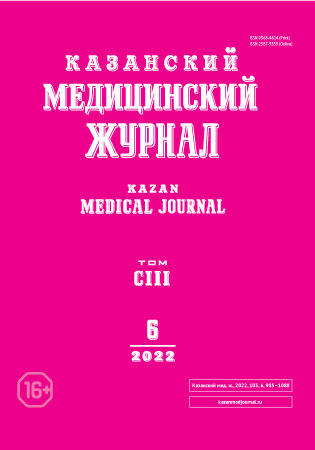Histopathology of patchy skin atrophy
- Authors: Nefedov V.P.1, Abdrakhmanov R.M.2, Davidov V.P.3
-
Affiliations:
- Republican Clinical Dermatovenerologic Dispensary
- Kazan State Medical University
- Medical and sanitary department of the Kazan (Volga Region) Federal University
- Issue: Vol 103, No 6 (2022)
- Pages: 1029-1033
- Section: Clinical experiences
- Submitted: 17.11.2022
- Accepted: 17.11.2022
- Published: 02.12.2022
- URL: https://kazanmedjournal.ru/kazanmedj/article/view/112616
- DOI: https://doi.org/10.17816/KMJ112616
- ID: 112616
Cite item
Abstract
Background. Description of the pathomorphology of patchy atrophy of the skin is found in rare publications on dermatology. At the same time, we noted a surge in the number of such cases over the past 3 years.
Aim. To study the detectability of patchy skin atrophy based on the materials of histological examination of skin biopsy specimens in the Republican Dermatovenerological Dispensary for 2016–2021, find out the most frequent localization of the process and determine the most characteristic pathomorphological signs of patchy skin atrophy.
Material and methods. The biopsy material of the skin from 816 patients, in which red spots on the skin of the trunk, arms and legs were clinically determined (clinical diagnoses were diverse) was studied. Histological preparations of the skin of patients were stained according to the standard method with hematoxylin and eosin.
Results. For 6 years (2016–2021) of studying and diagnosing 194 cases of patchy skin atrophy, the same frequency of the disease in men and women was noted (ratio 1:1). In men, patchy skin atrophy was more often detected in the young age group (up to 30 years), and in women, in the older age group (after 60 years). The most common localization of patchy skin atrophy is the trunk, extensor surface of the arms and lower leg. Histological examination of the skin in patients with patchy atrophy revealed two variants: with perivasculitis in the papillary dermis and without perivasculitis. We suggested two stages in the development of the disease: the first is the erythematous stage, the second is the sclerotic stage. The most characteristic pathomorphological signs of patchy skin atrophy are described.
Conclusion. An increase in the number of diagnosed cases of patchy skin atrophy was noted, the histological signs of which are a decrease in the number of rows of cells in the Malpighian layer, the disappearance of the basal and granular layers of the epidermis.
Keywords
Full Text
About the authors
Valery P. Nefedov
Republican Clinical Dermatovenerologic Dispensary
Email: nefedovvp1941@mail.ru
ORCID iD: 0000-0001-7936-6889
M.D., Cand. Sci. (Med.)
Russian Federation, Kazan, RussiaRasim M. Abdrakhmanov
Kazan State Medical University
Email: Kazanderma@yandex.ru
ORCID iD: 0000-0002-9657-2841
M.D., D. Sci. (Med.), Prof., Head of Depart., Depart. of Dermatovenerology
Russian Federation, Kazan, RussiaVitaly P. Davidov
Medical and sanitary department of the Kazan (Volga Region) Federal University
Author for correspondence.
Email: vitaliy.davydov1972@mail.ru
ORCID iD: 0000-0003-0151-353X
M.D., Head of Depart., Depart. of Pathology, University Clinic
Russian Federation, Kazan, RussiaReferences
- Lipets ME, Russach DF, Shibaeva LN, Gavrikov VV. To the question of a patchy skin atrophy. Vestnik dermatologii i venerologii. 1979;(6):43–45. (In Russ.)
- Verbenko EV, Tyutyunnikova IA. To the question of anetoderma. Vestnik dermatologii i venerologii. 1986;(1):42–43. (In Russ.)
- Kineston DP, Xia Y, Turiansky GW. Anetoderma: A case report and review of the literature. Cutis. 2008;81(6):501–506. PMID: 18666393.
- Tsvetkova GM, Mordovtseva VK. Patomorfologicheskaya diagnostika zabolevanij kozhi. (Pathomorphological diagnosis of skin diseases.) M.: Meditsina; 1986. 304 р. (In Russ.)
- Grzhebin ZN, Tselarius GS. Osnovy gistopatologii kozhi. (Basics of skin histopathology.) Мoscow: MEDGIZ; 1960. 360 р. (In Russ.)
- Kondratieva YuS, Eroshenko NV, Granina IA. Anetoderma in the practice of a dermatologist. Rossiyskiy zhurnal kozhnykh i venericheskikh bolezney. 2015;(1):21–24. (In Russ.)
- Mesnyankina OA, Ryabov SK. Jadassohn anetoderma: clinical observation. RUDN Journal of Medicine. 2021;25(3):243–247. (In Russ.) doi: 10.22363/2313-0245-2021-25-3-243-247.
- Gadzhimuradov MN. Cases of anetoderma in the practice of a dermatologist. Rossiyskiy zhurnal kozhnykh i venericheskikh bolezney. 2018;21(1):31–34. (In Russ.) doi: 10.18821/1560-9588-2018-21-1-31-34.
- Ruiz-Rodriguez R, Longaker M, Berger TG. Anetoderma and human immunodeficiency virus infection. Arch Dermatol. 1992;128(5):661–662. doi: 10.1001/archderm.128.5.661.
Supplementary files












